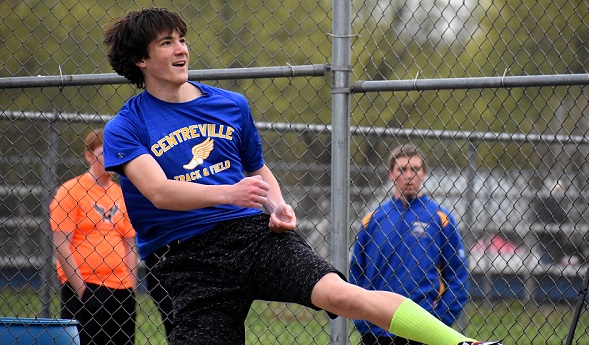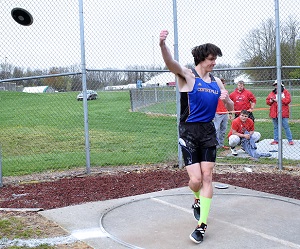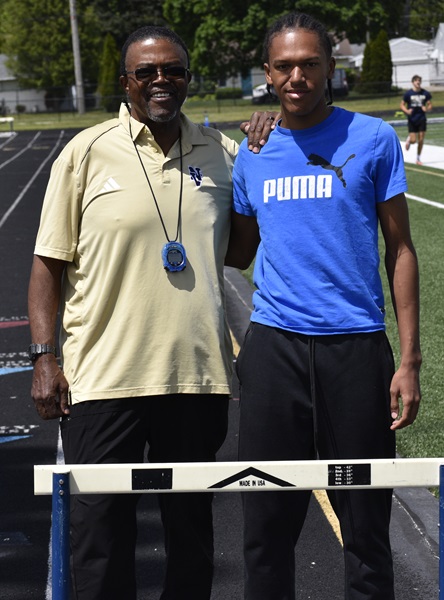
Self-Taught Overholt Firing Record Tosses
By
Wes Morgan
Special for MHSAA.com
May 10, 2019
We’re all students at YouTube University now, with information — some useful — accessible from experts around the globe. Trending this week are videos ranging from Gordon Ramsay’s breakfast tacos tutorial to step-by-step guides for picking locks with hairpins.
 Centreville senior Tyler Overholt made better use of his online browsing time, eventually stumbling upon Poland’s two-time Olympic silver medalist in the discus, Piotr Malachowski. Though he doesn’t know it, Malachowski became Overholt’s coach.
Centreville senior Tyler Overholt made better use of his online browsing time, eventually stumbling upon Poland’s two-time Olympic silver medalist in the discus, Piotr Malachowski. Though he doesn’t know it, Malachowski became Overholt’s coach.
An immeasurable amount of determination, and countless hours of watching film of Malachowski, led Overholt to break a 42-year-old school record earlier this year — a mark he since has bettered twice. At the White Pigeon Invitational in April, Overholt registered a distance of 155 feet, 7 inches to surpass Trent Grossman on the Bulldogs’ record board. A week later, Overholt made a toss of 160-6 in a meet that wasn’t officially finished due to inclement weather. In the following meet, he recorded a throw of 158-1.
“Let me tell you, I don’t smile much, but I had a big smile on my face,” said the soft-spoken Overholt, who earned Division 4 all-state status with a seventh-place finish after posting a mark of 138-3 at last year’s MHSAA Finals. “I was jumping up and down.”
Centreville jumped up to Division 3 this year, but Overholt’s marks still make him one of the favorites a few weeks from now at this year’s Finals at Jenison High School. Yet, you probably wouldn’t assume that with just a passing glance.
As a lanky freshman, Overholt was encouraged to try something other than discus. Still lanky now at 6-foot-6, 192 pounds, Overholt doesn’t look like a prototypical thrower.
But his fascination with the event only grew. As a sophomore, he approached new head coach Mike Hunter about giving it a try. Hunter, like most coaches at smaller schools, does the most he can to instruct his athletes in a wide variety of events. But he’s honest about a lack of expertise in the discus.
“He worked hard at the discus basically by himself,” Hunter said of Overholt. “He did some research and found some people. The hard thing with track is it is hard to coach every event if you don’t understand it, so to speak. I never did field events. I’ve tried to do the best I could to help him, but he’s done a lot on his own.
 “He has just worked hard and has great technique. It’s not just arming the thing out there. He’s been great to coach, and he’ll do what you ask him to do. He’s right (in the state championship mix) if he can relax and throw with confidence.”
“He has just worked hard and has great technique. It’s not just arming the thing out there. He’s been great to coach, and he’ll do what you ask him to do. He’s right (in the state championship mix) if he can relax and throw with confidence.”
Overholt, who also took on the shot put and hurdles for the first time this spring, knew mastering the technique could trump strength. So he studied Malachowski and other high-level throwers, had his mother, Debra, record his meets, and he broke down that film as well.
“For the first year, I just searched a lot of Olympic discus throwers and tried to copy them,” he said. “Then I started applying details into the spin. There was a lot of improvement, especially my junior year.”
Gaining 20 pounds over the last year has factored in as well after Overholt begrudgingly followed Hunter’s advice to spend more time in the weight room.
“I wasn’t really into it at first,” Overholt said. “It took me until my senior year to really start lifting. Now I’m a lot stronger.”
And more confident and experienced. He admitted that his performance at the
Finals last year was far from his best as he wrestled with the nerves that often come into play for first-timers. Overholt entered this season with the school record in his crosshairs, and now that he’s crossed that off his list, he’s chasing 170 feet. As a result of his success in the circle, his future plans have been altered in the last week.
Instead of going into the Navy after graduation, Overholt is headed to Olivet College, where he’ll throw for the Comets. He still intends to enlist in the Navy when he’s done.
“Some people are amazed by what I do and want to know the secret,” he said. “I’ve surprised myself.”
 Wes Morgan has reported for the Kalamazoo Gazette, ESPN and ESPNChicago.com, 247Sports and Blue & Gold Illustrated over the last 12 years and is the publisher of JoeInsider.com. He can be reached at [email protected] with story ideas for Berrien, Cass, St. Joseph and Branch counties.
Wes Morgan has reported for the Kalamazoo Gazette, ESPN and ESPNChicago.com, 247Sports and Blue & Gold Illustrated over the last 12 years and is the publisher of JoeInsider.com. He can be reached at [email protected] with story ideas for Berrien, Cass, St. Joseph and Branch counties.
PHOTOS: (Top) Centreville’s Tyler Overholt watches one of his discus tosses soar. (Middle) Overholt unloads a toss during a meet this spring. (Photos courtesy of JoeInsider.com.)
McCarey Caps Niles Career Among School's All-Time Track Greats
By
Scott Hassinger
Special for MHSAA.com
June 3, 2025
NILES – For such a decorated athlete, Niles track & field star Ayden McCarey is as humble as they come.
 That one trait is what makes him such a joy to coach, says Tony Todd, the Vikings' longtime leader of the boys program.
That one trait is what makes him such a joy to coach, says Tony Todd, the Vikings' longtime leader of the boys program.
Todd, a Flint Kearsley graduate and former participant himself in the oval sport, has seen many great performers during his 27 years directing Niles' program. But he contends that McCarey is one of the best he's ever coached.
McCarey, who has signed to run track at the Division II level at Grand Valley State University, capped off a glorious high school career during Saturday's Lower Peninsula Division 2 Finals in Hamilton.
McCarey returned home with all-state honors in two events, finishing second in the 110-meter high hurdles (14.43) and third-place in the 400-meter dash (49.27). His time in the 110s broke the school record. He has the second-fastest time at the school in the 400 dash, less than a second behind 2018 Niles grad Jordan Brown, currently the Vikings' sprint coach, who owns the record at 48.50.
McCarey also qualified in the 300 intermediate hurdles and ran anchor leg for the Vikings' 1,600 relay on Saturday.
"Ayden relishes the competition. The bigger the meet, the more he seems to rise to the occasion and perform well. When someone has a faster time, he can't wait to race against them. He gets excited over the chance to compete against someone faster," Todd said.
Also a standout defender for the Niles boys soccer team, McCarey finished runners-up in both the 110 highs and 400 his junior year. As a sophomore he placed sixth in the 110 and 10th in the 300. He began competing in the 400 midway through his sophomore season.
"It's just nice to know that all your hard work you put in got you to state. There's a lot of competition there. I am just happy to represent my school for a third time," McCarey said.
He credits an increase in distance workouts and his increased focus on the 400 as big reasons for his improvement in that event this season.
 "I try and focus on all my events, but it just so happened I spent the most time focusing on the 400 this season,” McCarey said. “You need a lot of stamina to run that event, and it also helps me in the longer hurdle race as well. I've been successful in the 110 highs because I concentrate on attacking it whereas most people sometimes hop over them and that slows them down and hurts their time. I get a good start, and I'm able to maintain my speed throughout the race."
"I try and focus on all my events, but it just so happened I spent the most time focusing on the 400 this season,” McCarey said. “You need a lot of stamina to run that event, and it also helps me in the longer hurdle race as well. I've been successful in the 110 highs because I concentrate on attacking it whereas most people sometimes hop over them and that slows them down and hurts their time. I get a good start, and I'm able to maintain my speed throughout the race."
McCarey owned the fastest time in the 400 among Lower Peninsula Division 2 competitors after the Regional meet. He was ranked second in the 110 highs and fourth in the 300 entering the Finals.
"Ayden goes non-stop and never complains. He's one of those kids that will run through a wall for you,” Todd said. “Sometimes I take advantage of that to get that extra effort out of him. He is very humble, and if you try and compliment him he just smiles and puts his head down and keeps going. I worry more than he does if he doesn't get the accolades that he should. He is a quiet kid who leads by example. His form in the hurdles has improved all four years."
McCarey went through his entire high school track career without an injury.
"That's a big thing. Coaches have to learn when to pull back. He's never had a serious injury that left him having to sit out a practice. You can attribute that to his extraordinary work ethic because if you slack off, that's one of the easiest ways to get hurt,” Todd said. “He stays in shape year round with his participation in soccer and track. He is very versatile and can compete at the state level in any event from the 100 up to the 400, along with the hurdles and relays.
"His conditioning and running that he does during his soccer practice builds his endurance for track. In turn, the speed he's developed in track helps him out on the soccer field."
McCarey is looking forward to competing in college.
"I decided to go to Grand Valley because they have a solid track program, and it’s not that far from home. I liked their business program there too," McCarey said.
Todd is looking forward to seeing what McCarey can do at the next level.
"The biggest thing that will make Ayden a valuable competitor in college is that he is a natural athlete. There is only so much you can coach,” Todd said. “It takes a good coach and a good athlete to make a champion. But 90 percent of that is the athlete. If they listen and do the workouts, they will succeed.
"I couldn't be more proud of his four-year high school career. He had the most outstanding track career ever at Niles High School, and he's a great human being and student. This young man is going to do great things at Grand Valley and in life. I'm proud to have been his coach for his entire high school career."
 Scott Hassinger is a contributing sportswriter for Leader Publications and previously served as the sports editor for the Three Rivers Commercial-News from 1994-2022. He can be reached at [email protected] with story ideas for Berrien, Cass, St. Joseph and Branch counties.
Scott Hassinger is a contributing sportswriter for Leader Publications and previously served as the sports editor for the Three Rivers Commercial-News from 1994-2022. He can be reached at [email protected] with story ideas for Berrien, Cass, St. Joseph and Branch counties.
PHOTOS (Top) Niles senior Ayden McCarey leaves the starting block during the 1600-meter relay at his team’s Regional. (Middle) Niles coach Tony Todd, left, takes a photo with McCarey before the start of a practice last week. (Photos by Scott Hassinger.)

